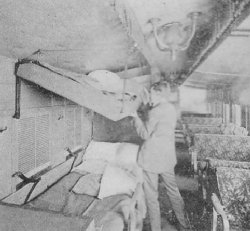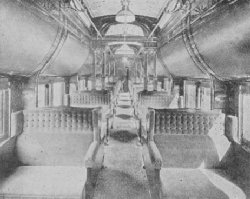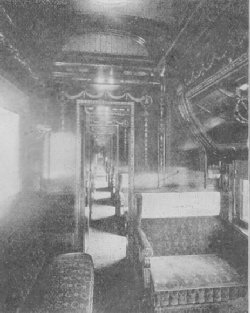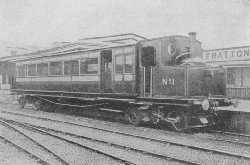Early or late in the evening, as convenience dictated, the traveler arrived at the door of his inn and was heartily welcomed. Boniface took him in, supplied him with good meat and drink, put him to bed in a four-poster, heavily curtained and valanced, aroused and breakfasted him in the morning, and sent him on his way rejoicing in being able to travel in a civilized manner in a civilized country.
Dwellers in the country and town alike were not all stay-at-home people, and even if travelers on pleasure or business were comparatively few, the necessities of commerce kept the roads busy.
With the exit of the mail-coach and the entrance of the train, night traveling entered upon a new development; but for a very long time there was very little improvement in the conditions of travel, save in the one item of speed. Night expresses, rare at first, became numerous, and passengers many of whom could remember the old methods of road travel, became accustomed to the idea of being whirled from London to Edinburgh, or from London to Penzance, during the brief hours of a single night. Although an immensely increased speed was gained, little was done to provide in any special way for the comfort of passengers at night. They crowded themselves into their corners and slumbered uneasily through the weary hours, as the train thundered and roared through the sleeping country. The London and South-Western Railway is experimenting with motor-coaches for the lighter suburban traffic. The coaches are fifty-six feet long, and are divided into two compartments, accommodating ten first-class and thirty-two third-class passengers, and one ton of luggage. The engine can attain a velocity of thirty miles an hour in thirty seconds. But at last, imported from America, where the great distances to be traversed acted as a stimulant to the ingenuity of inventors, there dawned upon railway managers the idea of sleeping berths, and sleeping cars have worked almost as a great a revolution in night travel for those who can afford them, as the coming of the railway has in the conditions of travel generally. Night travel need no longer be a thorn in the flesh of the traveler who can engage a berth in a sleeper, and even for the much larger number who know nothing of sleeping berths, the immense improvements which recent years have brought in the construction and fittings of railway carriages, and in their smoothness and rapidity of motion, have robbed night travel of much of its old discomfort and wearing fatigue.
A NEW TYPE OF PASSENGER LOCOMOTIVE
The accompanying cut, above, shows a simple passenger locomotive, which is especially interesting as being of about the normal size attained by the eight-wheel engine before it developed into the Atlantic type. The following are its dimensions and distinguishing features: Cylinders, 19 by 28 inches; the boiler pressure is 200 pounds, and the driving wheels, 79 inches in diameter, give atractive effort of 21,751 pounds. With these dimensions the eight-wheel engine would have had a grate area of about 29.16 square feet and a total heating surface of about 2352.8 square feet, of which 180 square feet would have been in the firebox and 2172 in the tubes. By adopting the trailer, the grate area has been increased to 45.1 square feet, and the total heating surface to 2878.75 square feet, of which the tubes contain 2716.75 square feet and the fire-box 162 square feet, or, in other words, the increases have been 525.9 square feet in total heating surfaces, and 15.94 square feet in grate area. The result, however, is a locomotive with much greater boiler capacity than could have been supplied to an eight-wheel engine with the same weight per driving axle. The main driving axle, by the way, is of nickel steel, the others being of iron.
THE CANADIAN LUMBER INDUSTRY |




